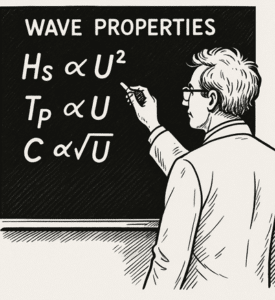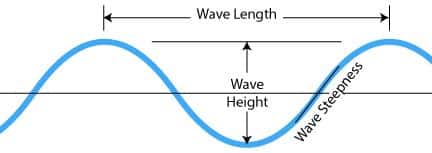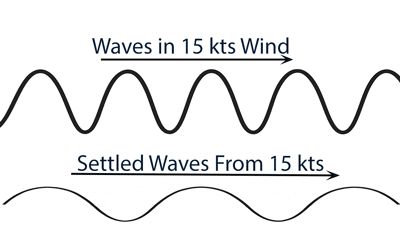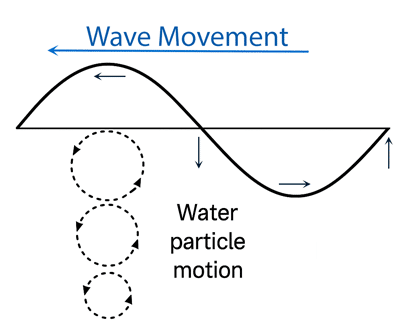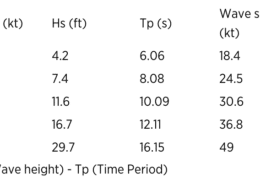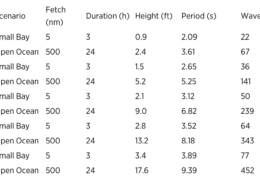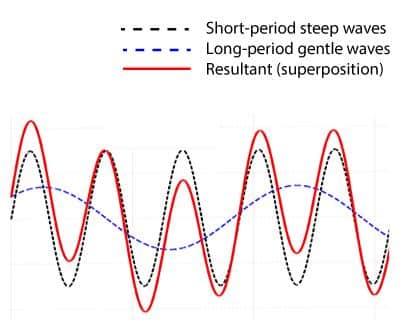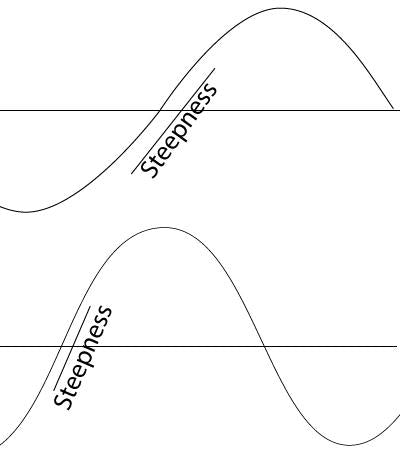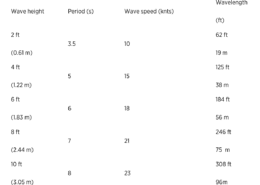A Fascination with Waves Can Create a Poetic Justice to Our Own Being
Article shared by Mustang Survival, the leader in PFDs and marine safety products.
Are we alive because of waves?
A fascination with waves can create a poetic justice to our own being. We think of storms as bad, but imagine an Earth having never seen a wave formed from a storm. It is probably fair to say life as we know it would likely have been radically delayed, different, or perhaps impossible without the restless surface of the sea moving nutrients and gases around. The oceans would be a stagnant pond. Without wave and tide action, the “primordial soup” might not have reached the concentrations needed for complex chemistry.
What can waves philosophically mean?
Philosophically, waves remind us of legacy. A storm is brief, its winds fleeting, yet the energy it imparts can travel across entire oceans long after the tempest has passed. More than that, the turbulence that formed the wave does not remain chaotic; over distance, it smooths into long, steady swells. In life, too, the rough forces that once battered us can be transformed into something calmer and stronger. What begins as turmoil can become momentum—carrying us farther, steadier, and with more grace than the storm itself. As humans we too have the power to become the smooth and energy-bearing swell, not the storm.
The Physical World
So now that we’ve piqued your interest in waves, namely you would not be alive today were it not for waves, let’s dive in and learn some things about waves that will keep you out of danger and alive.
Speaking of staying alive, the learnings below show you how boating and the water can be incredibly dangerous. This is why we always recommend wearing a properly fitting, in good serviceable condition, and approved life jacket.
From statistical analysis over many years of drowning studies, the US Coast Guard categorically proved that comfortable fitting Personal Flotation Devices (PFDs – life jackets) significantly reduced the number of drownings, especially in children. This was attributed to people continuing to wear the life jacket as a matter of habit and not taking it off because it was uncomfortable. Mustang Survival has a full range of comfortable-fitting kids and adult PFDs and a full range of inflatable PFDs make it easy to stay protected without sacrificing comfort or mobility. At the end of the day, the best life jacket is the one you wear.
How are waves formed?
Waves are formed by the wind imparting its energy into the water. Friction between the moving wind and still water creates tiny ripples. Now the wind has something to “grab onto”. You can imagine the back of a small ripple being pushed on by the wind, making the ripple get bigger – and then bigger, turning them into waves. Given enough wind strength (velocity), distance over which the wind acts, and time the waves grow bigger – sometimes to 100 ft (30m) or more – all from just the wind.
What determines the size of the wave?
- Velocity of wind
- The amount of time the wind acts on the waves
- The distance (called “fetch”) over which the wind is acting on the wave
The high wind speed over a long period of time over a long distance produces higher waves.
For example, in the open ocean a 15 knot wind acting for only a few hours would produce smaller waves than a 15 knot wind that lasted for several days. But there is a limit to the size of the wave given a specific wind velocity because a wind with a specific velocity has only a specific amount of energy it can give up. Thus wave height is determined by wind speed.
Do waves have a maximum size that they can grow to?
Yes. Scientists have developed empirical formulas for the theoretical size that a wave can grow to a given steady wind speed. They also have a different set of formulas for the wave characteristics after the wind has gone and the wave has settled to a swell
For example, our 15 knot steady wind above could only ever produce a wave that rises to 5.2 feet. Once the wind has gone, the wave settles to a swell which is only 4.2 ft.
Read on, we will explain that.
What are the main characteristics of a wave?
- Height (vertical distance from the bottom of the trough to the top of the crest)
- Wavelength (the horizontal distance from one crest to the next)
- Period (time from one crest to the next past a fixed point on the bottom)
- Frequency (waves per time unit (usually seconds) past a fixed point)
- Speed of the wave (how fast is the crest moving relative to the bottom)
- Steepness (measured at the midsection of the wave)
- Vertical Acceleration (the rate at which the vertical speed of your body on a small boat is changing.
- Energy (although not really a measurable quantity, waves have energy. The energy can only be dissipated over a long distance – or by crashing into the beach)
What is fetch and why is it important?
Fetch is the distance over which the wind continuously acts over the water. It is related to the amount of time that the wind is acting on the water. The longer the wind acts on a wave, the bigger the wave can grow towards its maximum size.
What’s the difference between wind waves and swell?
Waves that are being acted on by the wind still have energy being pumped into them. Thus they tend to be higher and have a shorter distance between the waves, yet surprisingly, they run slower.
A swell is a wave that has outrun the wind and is no longer growing due to wind. The wind may have reduced to zero but the swell wave carries on freely because of the energy it has can only dissipate over time and distance.
Mechanics: How Energy Moves
How does the wave carry energy?
The wind pushes on the back side of the wave. The wave moves with the wind. But despite what you might think, the water is not traveling with the waves. The water particles do move (slightly) – at the top of the crest they move forward but at the trough they move backward. This creates a circular movement of the particles.
Think of an ocean wave carrying energy like a cheering crowd in a stadium where a small group of people start a wave by standing up, waving, and sitting down. The wave carries around the stadium but the people (water particles) only stand up and sit down in the same place. The wave (cheering energy) carries on until the energy in the crowd calms over time. Perhaps the other side scores, killing the energy like a wave crashing into the beach and stopping.
So now you understand that it is energy moving not water. The energy is propagated forward with the help of gravity and the cyclic movement of water. As the wave rises, gravity is pulling the wave back down along with its forward-moving water at the crest. This continues the movement of the wave crest without the need for the water to continue moving forward. Intuitively, we think that there must be a lot of energy to lift up that amount of water to a crest but what is actually happening is that the gravity is just replacing the trough. That constant tug-of-war between orbital motion and gravity is why waves keep rolling, even long after the wind has died. i.e., virtually no energy is lost in a wave going through its cycle.
Why do waves get taller and steeper in shallow water? The seabed interferes with the orbital motion, compressing the wave energy and forcing the wave upward into height.
Wave Behavior
What is the difference between a fully developed wave over a long fetch still in the wind and a wave generated by wind but where the wind has gone.
Back to energy – the wave in the wind still has wind imparting its energy to it by pushing on the back side of the wave. This makes the waves higher and closer together. Waves that are higher and closer together, are steeper. Steep waves that come by more often affect your inner ear balance and thus make you more uncomfortable (seasickness).
A wave generated by a steady long fetch will rise to a specific maximum height. For example, for a 15 knot wind, that wave will have risen to a maximum of 5.2 ft, be 5 seconds apart from one crest to the next.
After the wind has gone, a wave that has risen to a height has a specific settled characteristic.
Continuing the 15 knot wind example, the 5.2 ft wave height at 5 seconds apart will settle to a 4.2 ft height and be 6 seconds apart from one crest to the other. This is the resultant swell that will travel across the ocean – losing height very very slowly over maybe thousands of miles of travel.
Both the in-wind wave and the after-wind waves (swell) carry the same amount of energy but are different shapes because the wind has stopped imparting any energy. The reason being is that the 4.2 ft wave has now settled to its natural frequency. You might say that the wave likes to travel or is more “natural” to travel in such a manner. This is much like a pendulum has a natural frequency – when you shorten the rope, the natural swinging frequency is different from if you lengthened the rope. In the same manner, waves that begin with a different height due to the intensity of a storm over long distances have different settled height and characteristic.
To summarize the above: Without constant energy input, short steep waves dissipate, leaving only the long-period natural rhythm waves.
Can a wave travel faster than the wind that created it? Yes. Once freed, speed is set by wavelength, not the wind that birthed it. Wow, that can win you a bet at a bar! Remember waves are not water moving, they are energy moving. A tsunami can travel at 450 knots – that is as fast as an airliner but it is not the water that is traveling. It is the energy. As the energy gets into shallower water the energy is compressed which causes the water to rise up. The rising water slows the energy travelling rate. The rising water causes a wave that is pulled forward by gravity.
Wave dynamics are different from tsunamis, but the similarity is in the energy. Here is a table of original storm wind speed versus the wave speed. How this works is that while in the storm, a developed wave travels at a similar speed as the wind. It is high with short time periods between each wave. As the wind drops away the wave settles to its natural frequency and height, which by it’s own energy nature means that it must speed up. This is akin to a skater who spins. By pulling in her arms tight to her body, her spin speed increases without any outside interference. Thus she has a natural spin speed based on her dynamics which is set by the initial starting speed. With waves, the waves grow to a certain height based on the initial wind speed and then settle to a different height and speed.
The formulas developed by scientists that predict wave and swell characteristics were generated empirically, meaning that they were done from real measurements on ocean buoys of real wave characteristics after the known characteristics of a storm has passed.
This table shows settled wave characteristics from an initiating long fetch storm. Notice the wave speed faster than the initiating wind speed.
The empirical formulas show that wave height increases with the square of the wind speed – that the time period increases proportionally with the wind speed as does the speed of the wave. So notice three more things in the table, as you double the wind speed the wave height goes up 4 times, the wave period doubles and the wave speed doubles.
You might think that a 49 kt wave speed seems impossible, but remember these come from real measurements.
What if fetch and time on the waves are reduced?
All the above discussions and formulas are on fully developed waves where enough fetch and time were able to act on the waves, allowing them to develop to their maximum. Also assumed was deep water where the bottom was far enough away to not compress the energy, causing the waves to rise.
When fetch and time and depth are smaller, the waves have different characteristics. The waves tend to have less height but also become shorter in period.
The table below gives different scenarios of a small bay with short wind fetch and duration versus the open ocean with long fetch and duration. Notice that for the same wind speeds the wave height increases in the open ocean, which is obvious but not obvious is the shortened wavelength in the small bay. The waves are choppier (faster period) in the small bay.
Growth and Limits
How does the growth of waves happen during a storm?
From the above discussion, a short duration gives choppier waves. So as a storm is starting and developing and traveling to new water areas the waves are choppier. As the storm develops those waves tend to want to go more to their natural frequency where the waves speed up and spread out. BUT new waves are being formed at the same time making the sea very confused. Short slow waves being impacted by large faster waves. It is a mess for sure and growing in danger because the boat is hit by different sized waves from different directions if the storm is turning.
How do waves interact with other waves?
When one wave overtakes or hits another wave the size of the wave is additive – this is called superposition. Thus one 20 ft fully developed wave running fast hits another 10 ft newly developed wave running slow the total height will be 30 feet.
Here is a diagram of resultant waves when two waves series of different period and height meet. Notice how the resultant waves can be steeper and higher, creating an unpredictable, rough ride for sure.
Why are some waves in a storm breaking and others not?
Waves break when their steepness reaches a certain point. If a small slow wave is overtaken by a large wave then the total wave becomes very steep. The next wave and a few others after will not have this wave upon wave effect and thus not so steep.
What happens when waves reach the same speed as the wind?
As the wave speed increases to match the wind speed, the energy imparted to the wave reduces because there is no relative wind speed on the wave. Without additive energy, the wave begins to settle into its natural state and actually speeds up – going faster than the wind.
What is wave steepness and why is it important?
A wave is steepest at its midpoint. The closer the crests and the higher the wave, the steeper the wave becomes. Steep waves moving fast give higher vertical acceleration to a human body in a boat. Seasickness is a dual function of vertical acceleration and the time between each accelerating period. So steeper waves cause a greater propensity to become seasick.
When does a wave break?
In deep water at ~1/7 steepness, or when height reaches ~0.78 of depth in shallow water. This is why you see white caps in about 12 knots of wind. The wind causes the waves to be close together and steep. At the beach, when a wave moving in becomes ¾ of the depth, the wave will break.
How do currents and opposing winds change waves?
The water particles moving forward at the top of a wave are opposed by the current moving back against it. This shortens the wavelengths and increases steepness, which can lead to breaking waves.
Staying Safe in Rough Sea States
When seas become rougher (especially offshore, where waves are higher, closer together, and more fatiguing), the risk isn’t just discomfort.
The constant acceleration and spray can quickly disorient boaters and increase the chance of falling overboard. In these conditions, wearing the right offshore-rated PFD is critical. A model like the award-winning Mustang Survival Atlas is designed for open-water environments, where long exposure to wind and waves demands both buoyancy and comfort over time.
For added protection, the Atlas integrates a spray hood when inflated, a feature especially important offshore. In rough seas, even strong swimmers can struggle if constant spray enters their airway. A spray hood helps shield the face, reducing the chance of secondary drowning from water inhalation and giving you more time and clarity to respond.
In other words, offshore-specific gear doesn’t just keep you afloat…it helps you stay breathing and alert when sea states are at their worst.
Human Experience
At what point in the wave cycle do we feel the strongest acceleration?
At the bottom of the trough you have just come down off the back of the wave and moving down to now all of a sudden moving up. This is where you feel the strongest vertical acceleration. Think back to your roller coaster days.
At what vertical acceleration become uncomfortable and what would be the wave dynamic?
At about 3-feet/sec of vertical acceleration paired with a frequency of this happening every 3-7 seconds does one tends to become very uncomfortable. See this table for the typical wave dynamic point at which this begins to happen for different wave heights. For example, a 4 ft high wave hitting your boat every 5 seconds would give you 3-feet/s of vertical acceleration and is in the zone of happening every 3 to 7 seconds. Note that a 10 ft wave with a typical period of 8 seconds could be more comfortable than a 2 ft wave both with 3-feet/s of vertical acceleration. It depends on the frequency as humans just don’t like anything in the 3-7 second frequency.
Broader Reflections and Real and Philosophical Application
Do waves play a role in Earth’s origin of life?
It is believed so. Breaking waves mix gases. All waves cycle nutrients, and concentrate molecules, likely helping ocean life begin and sustain. Just as with the moon creating tides that help the ocean move.
How can boaters use forecasts to anticipate real conditions?
By looking at wind speed, wave height, wave period, and and combined with predicted swell, boaters can judge comfort and potential danger.
Here is a quick step-by-step summary of the growth and decline of waves as a storm comes and passes:
1. Early Stage (short duration, short fetch)
- Wind just begins to blow.
- Waves are small, steep, and close together (short period).
- Sea feels choppy and chaotic, with hard slamming motion.
2. Developing Stage (sustained winds, growing fetch)
- Waves continue to grow taller.
- Some components start to lengthen toward their natural frequency (longer period, faster crests).
- But new short waves are still being created at the surface.
- Result: mixed spectrum — long, faster waves overrunning short, steep ones.
- Sea feels very confused — dangerous, because the boat gets hit by waves of different sizes and speeds from different angles.
3. Mature Stage (fully developed sea)
- Energy input and dissipation reach balance.
- Dominant waves are long-period, higher, and smoother.
- Local “chop” is still present, but the sea is more organized.
- This is when the dominant wave speed may slightly outrun the wind.
4. Decay Stage (storm passes or wind drops)
- Without wind input, the shorter, steeper waves quickly dissipate.
- Only long, fast swell continues to travel outward, carrying the storm’s memory across the ocean.
- Sea becomes more regular and rolling, though still powerful.
What You Learned
At the start of a storm, the sea is a nasty chop. As the storm builds, some waves stretch into long-period swells while new short waves are born on top of them. The clash of short, slow chop with big, fast swell makes the sea state confused and dangerous. Once the wind finally settles, the mess organizes into long rolling swell that runs free of the storm.
You can learn more with NauticEd

Sign up with NauticEd for FREE (no obligation) and receive 2 free boating courses, a free eLogbook and boating resume, and more! If you want to get started in boating or are experienced and want to expand your knowledge and skills, consider taking our many online sailing and powerboating courses.



